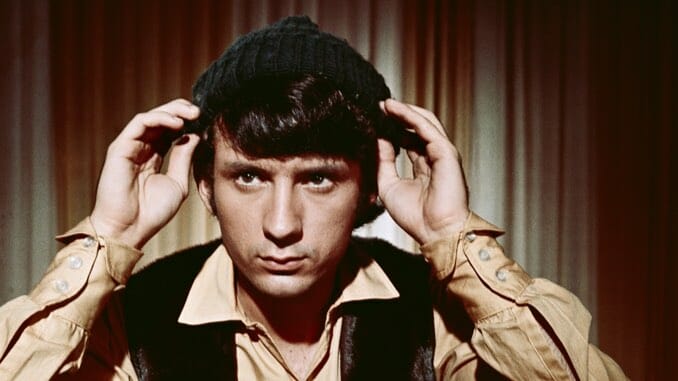There Was Much More to Michael Nesmith Than The Monkees
Photo by Michael Ochs Archives/Getty
Michael Nesmith, who died Friday at his California home of heart failure at age 78, never lost his ambivalence about his best-known musical endeavor: The Monkees. On the one hand, most people know him as a member of that made-for-TV rock ‘n’ roll band during its two-year run on NBC-TV, 1966-1968. On the other hand, he was proudest of the music he made as a struggling folk singer before the TV show, and as a pioneering country-rocker and music-videographer after the show.
Those mixed feelings were obvious the last time I saw him. Michael Nesmith & The First National Band headlined the Country Music Hall of Fame’s CMA Theatre on Sept. 11, 2018. The 19-song set included only a single Monkees song—and that tune, “Papa Gene’s Blues,” dated back to Nesmith’s pre-Monkees folkie career.
And yet Nesmith had just done a summer tour with his old bandmate, billed as “The Monkees Present: The Mike Nesmith & Micky Dolenz Show.” Dominated by Monkees songs, the tour proved so successful that the duo reprised it in 2019 and 2021. Clearly, he was torn between the two sides of his career.
Some in the Hall of Fame audience were unmistakably disappointed at the absence of Monkees songs, but others were just as obviously gratified. This latter group believed that Nesmith deserves to be remembered not as a TV sitcom star, but as an unheralded pioneer of the country-rock movement. The singer dressed the part, wearing a big, white cowboy hat embellished with stars in red and blue sequins.
After all, his first country-flavored solo album, Magnetic South, credited to Michael Nesmith & The First National Band, was released in June 1970, before the debut albums of The Eagles, Pure Prairie League and The New Riders of the Purple Sage. This argument neglects to mention that the Byrds’ Sweetheart of the Rodeo, The Flying Burrito Brothers’ The Gilded Palace of Sin, Bob Dylan’s John Wesley Harding and the first two Poco albums all predate Magnetic South.
Which is not to deny that Nesmith was a legitimate member of that first wave of Sweetheart-inspired country-rock. Magnetic South featured “Joanne,” the only top-40 solo single of his career, and when he sang it at the Hall of Fame, it still had that captivating, rising chorus melody, the swooping vocal shadowed by the steel guitar. At the 2019 show, the steel was provided by virtuoso Pete Finney, and the harmony vocals by two of Nesmith’s sons, John and Christian. Their father seemed bashful, surprised and pleased all at once when the song got the biggest cheers of the night.
In the show’s second half, Nesmith sent his eight backing musicians offstage and recreated the three-song set he performed on many Monday nights as the barely known M.C. of the open-mic folk-singer night at Los Angeles’ legendary Troubadour nightclub. Standing alone on stage with a 12-string guitar, as he had back in 1965, he played “Propinquity,” “Different Drum” and “Papa Gene’s Blues” for the Hall of Fame crowd. That middle song is arguably his best composition, for its theme of a young person not ready to settle down is reinforced by its bouncy and ready-to-ramble melody, especially on the bridge that goes, “I’m not saying you ain’t pretty / All I’m saying’s I’m not ready.”
A little-known singer at the Troubadour named Linda Ronstadt heard it and recorded it with her trio, Stone Poneys. The result was a #13 pop single in 1967, the first hit of her career. The Stone Poneys used another Nesmith composition, “Some of Shelly’s Blues,” as the A-side of a 1968 single, but with less success.
Between those Troubadour shows and the Stone Poney singles, however, Nesmith had answered a Daily Variety ad announcing auditions for a new TV show, to cast “Folk & Roll Musicians-Singers for acting roles in new TV series. Running parts for 4 insane boys, age 17-21.” He got one of the four slots alongside Dolenz (a child actor with some band experience), Davy Jones (a British musical theater prodigy) and Peter Tork (a Greenwich Village folkie).
The show was the brainchild of TV producers Bert Schneider and Bob Rafelson, who wanted to translate the loosey-goosey mix of comedy and music in Richard Lester’s Beatles movie, A Hard Day’s Night, for the more circumscribed world of American television. The producers thought of building the show around a pre-existing band, The Lovin’ Spoonful, but realized such experienced musicians would be less pliable to manipulation and less appealing to junior-high girls.
Rafelson, who would go on to direct such landmark movies as Five Easy Pieces, The King of Marvin Gardens and The Postman Always Rings Twice, all three starring a young Jack Nicholson, was a gifted filmmaker. In 1968, he would make The Monkees’ bizarrely experimental feature film, Head, with appearances by Nicholson, Frank Zappa and Annette Funicello.
-

-

-

-

- Curated Home Page Articles By Test Admin October 21, 2025 | 3:10pm
-

- Curated Home Page Articles By Test Admin October 21, 2025 | 2:57pm
- Urls By Test Admin October 21, 2025 | 2:57pm
- Curated Home Page Articles By Test Admin October 21, 2025 | 2:55pm
-

-

-

-

-

-

-

-

-

-

-

-

-

-

-

-

-

-

-

-

-

-

-

-

-

-

-

-

-

-

-




































